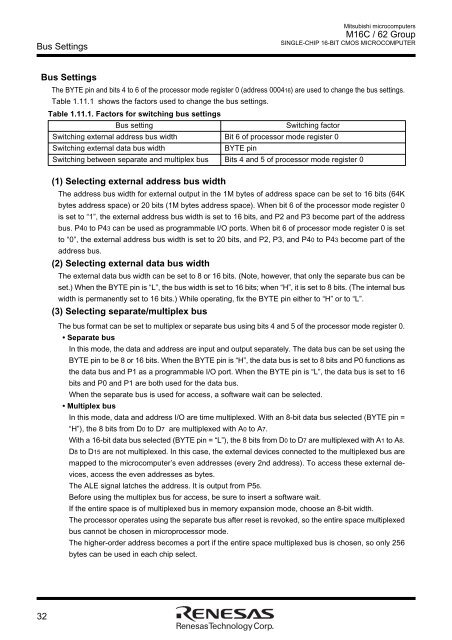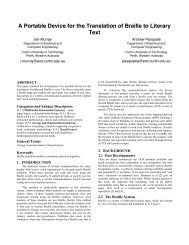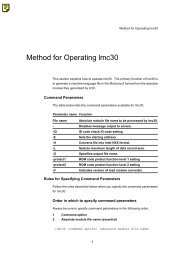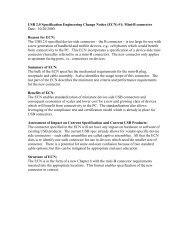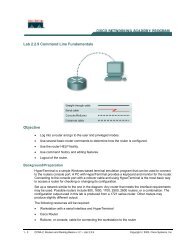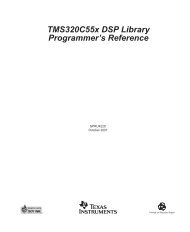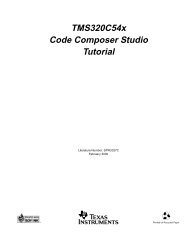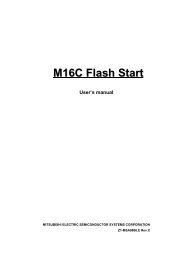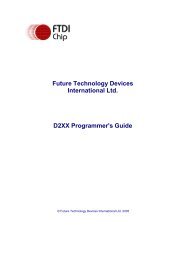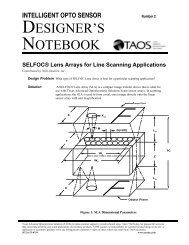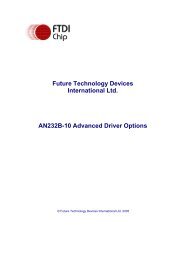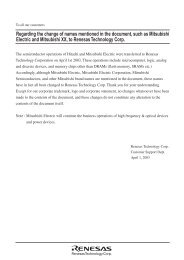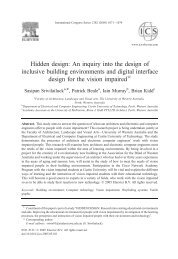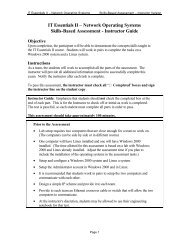- Page 1 and 2: To all our customersRegarding the c
- Page 3 and 4: Keep safety first in your circuit d
- Page 5 and 6: This manual comprises of eight chap
- Page 7 and 8: Table of ContentsChapter 1 Hardware
- Page 9 and 10: 2.5 Clock-Asynchronous Serial I/O (
- Page 11 and 12: 4.2.1 Interrupt Enable Flag .......
- Page 13 and 14: Quick Reference to Pages Classified
- Page 15 and 16: Quick Reference to Pages Classified
- Page 17 and 18: DescriptionMitsubishi microcomputer
- Page 19 and 20: DescriptionMitsubishi microcomputer
- Page 21 and 22: DescriptionMitsubishi microcomputer
- Page 23 and 24: DescriptionMitsubishi microcomputer
- Page 25 and 26: Pin DescriptionMitsubishi microcomp
- Page 27 and 28: CPUMitsubishi microcomputersM16C /
- Page 29 and 30: CPUMitsubishi microcomputersM16C /
- Page 31 and 32: ResetMitsubishi microcomputersM16C
- Page 33 and 34: ResetMitsubishi microcomputersM16C
- Page 35 and 36: SFRMitsubishi microcomputersM16C /
- Page 37 and 38: Memory Space Expansion FunctionsMit
- Page 39 and 40: Memory Space Expansion FunctionsMit
- Page 41 and 42: Memory Space Expansion FunctionsMit
- Page 43 and 44: Software ResetMitsubishi microcompu
- Page 45: Processor ModeMitsubishi microcompu
- Page 49 and 50: Specified address rangeBus ControlM
- Page 51 and 52: Bus ControlMitsubishi microcomputer
- Page 53 and 54: Bus ControlMitsubishi microcomputer
- Page 55 and 56: Bus ControlMitsubishi microcomputer
- Page 57 and 58: Clock Generating CircuitMitsubishi
- Page 59 and 60: Clock Generating CircuitMitsubishi
- Page 61 and 62: Wait ModeMitsubishi microcomputersM
- Page 63 and 64: Power controlMitsubishi microcomput
- Page 65 and 66: ProtectionMitsubishi microcomputers
- Page 67 and 68: InterruptMitsubishi microcomputersM
- Page 69 and 70: InterruptMitsubishi microcomputersM
- Page 71 and 72: InterruptMitsubishi microcomputersM
- Page 73 and 74: InterruptMitsubishi microcomputersM
- Page 75 and 76: InterruptMitsubishi microcomputersM
- Page 77 and 78: InterruptMitsubishi microcomputersM
- Page 79 and 80: InterruptMitsubishi microcomputersM
- Page 81 and 82: ______INT InterruptMitsubishi micro
- Page 83 and 84: Address Match InterruptMitsubishi m
- Page 85 and 86: Precautions for InterruptsMitsubish
- Page 87 and 88: Watchdog TimerMitsubishi microcompu
- Page 89 and 90: DMACMitsubishi microcomputersM16C /
- Page 91 and 92: DMACMitsubishi microcomputersM16C /
- Page 93 and 94: DMACMitsubishi microcomputersM16C /
- Page 95 and 96: DMACMitsubishi microcomputersM16C /
- Page 97 and 98:
DMACMitsubishi microcomputersM16C /
- Page 99 and 100:
TimerMitsubishi microcomputersM16C
- Page 101 and 102:
Timer AMitsubishi microcomputersM16
- Page 103 and 104:
Timer AMitsubishi microcomputersM16
- Page 105 and 106:
Timer AMitsubishi microcomputersM16
- Page 107 and 108:
Timer AMitsubishi microcomputersM16
- Page 109 and 110:
Timer AMitsubishi microcomputersM16
- Page 111 and 112:
Timer BMitsubishi microcomputersM16
- Page 113 and 114:
Timer BMitsubishi microcomputersM16
- Page 115 and 116:
Timer BMitsubishi microcomputersM16
- Page 117 and 118:
Timers’ functions for three-phase
- Page 119 and 120:
Timers’ functions for three-phase
- Page 121 and 122:
Timers’ functions for three-phase
- Page 123 and 124:
Timers’ functions for three-phase
- Page 125 and 126:
Timers’ functions for three-phase
- Page 127 and 128:
Timers’ functions for three-phase
- Page 129 and 130:
Serial I/OMitsubishi microcomputers
- Page 131 and 132:
Serial I/OMitsubishi microcomputers
- Page 133 and 134:
Serial I/OMitsubishi microcomputers
- Page 135 and 136:
Serial I/OMitsubishi microcomputers
- Page 137 and 138:
Clock synchronous serial I/O modeMi
- Page 139 and 140:
Clock synchronous serial I/O modeMi
- Page 141 and 142:
Clock synchronous serial I/O modeMi
- Page 143 and 144:
Clock synchronous serial I/O modeMi
- Page 145 and 146:
Clock asynchronous serial I/O (UART
- Page 147 and 148:
Clock asynchronous serial I/O (UART
- Page 149 and 150:
Clock asynchronous serial I/O (UART
- Page 151 and 152:
Clock asynchronous serial I/O (UART
- Page 153 and 154:
Clock asynchronous serial I/O (UART
- Page 155 and 156:
Clock asynchronous serial I/O (UART
- Page 157 and 158:
UART2 Special Mode RegisterMitsubis
- Page 159 and 160:
UART2 Special Mode RegisterMitsubis
- Page 161 and 162:
UART2 Special Mode Register 2Mitsub
- Page 163 and 164:
UART2 Special Mode Register 2Mitsub
- Page 165 and 166:
S I/O3, 4Mitsubishi microcomputersM
- Page 167 and 168:
S I/O3, 4Mitsubishi microcomputersM
- Page 169 and 170:
A-D ConverterMitsubishi microcomput
- Page 171 and 172:
A-D ConverterMitsubishi microcomput
- Page 173 and 174:
A-D ConverterMitsubishi microcomput
- Page 175 and 176:
A-D ConverterMitsubishi microcomput
- Page 177 and 178:
A-D ConverterMitsubishi microcomput
- Page 179 and 180:
D-A ConverterMitsubishi microcomput
- Page 181 and 182:
CRCMitsubishi microcomputersM16C /
- Page 183 and 184:
Programmable I/O PortMitsubishi mic
- Page 185 and 186:
Programmable I/O PortMitsubishi mic
- Page 187 and 188:
Programmable I/O PortMitsubishi mic
- Page 189 and 190:
Programmable I/O PortMitsubishi mic
- Page 191 and 192:
Programmable I/O PortMitsubishi mic
- Page 193 and 194:
Usage precautionMitsubishi microcom
- Page 195 and 196:
Usage precautionMitsubishi microcom
- Page 197 and 198:
Electrical characteristicsMitsubish
- Page 199 and 200:
Electrical characteristics (Vcc = 5
- Page 201 and 202:
Timing (VCC=5V)Mitsubishi microcomp
- Page 203 and 204:
Timing (VCC=5V)Mitsubishi microcomp
- Page 205 and 206:
Timing (VCC=5V)Mitsubishi microcomp
- Page 207 and 208:
TimingMitsubishi microcomputersM16C
- Page 209 and 210:
Timing (Vcc = 5V)Mitsubishi microco
- Page 211 and 212:
Timing (Vcc = 5V)Mitsubishi microco
- Page 213 and 214:
Electrical characteristics (Vcc = 3
- Page 215 and 216:
Timing (Vcc = 3V)Mitsubishi microco
- Page 217 and 218:
Timing (Vcc = 3V)Mitsubishi microco
- Page 219 and 220:
Timing (Vcc = 3V)Mitsubishi microco
- Page 221 and 222:
Timing (Vcc = 3V)Mitsubishi microco
- Page 223 and 224:
Timing (Vcc = 3V)Mitsubishi microco
- Page 225 and 226:
Timing (Vcc = 3V)Mitsubishi microco
- Page 227 and 228:
Mitsubishi microcomputersM16C / 62
- Page 229 and 230:
IssuancesignatureReceiptMitsubishi
- Page 231 and 232:
Mitsubishi microcomputersM16C / 62
- Page 233 and 234:
Mitsubishi microcomputersM16C / 62
- Page 235 and 236:
IssuancesignatureReceiptMitsubishi
- Page 237 and 238:
Mitsubishi microcomputersM16C / 62
- Page 239 and 240:
Mitsubishi microcomputersM16C / 62
- Page 241 and 242:
IssuancesignatureReceiptMitsubishi
- Page 243 and 244:
Mitsubishi microcomputersM16C / 62
- Page 245 and 246:
Mitsubishi microcomputersM16C / 62
- Page 247 and 248:
IssuancesignatureReceiptMitsubishi
- Page 249 and 250:
Mitsubishi microcomputersM16C / 62
- Page 251 and 252:
Description (Flash Memory Version)M
- Page 253 and 254:
CPU Rewrite Mode (Flash Memory Vers
- Page 255 and 256:
CPU Rewrite Mode (Flash Memory Vers
- Page 257 and 258:
CPU Rewrite Mode (Flash Memory Vers
- Page 259 and 260:
CPU Rewrite Mode (Flash Memory Vers
- Page 261 and 262:
CPU Rewrite Mode (Flash Memory Vers
- Page 263 and 264:
CPU Rewrite Mode (Flash Memory Vers
- Page 265 and 266:
Functions To Inhibit Rewriting (Fla
- Page 267 and 268:
Appendix Parallel I/O Mode (Flash M
- Page 269 and 270:
Appendix Standard Serial I/O Mode (
- Page 271 and 272:
Appendix Standard Serial I/O Mode (
- Page 273 and 274:
Appendix Standard Serial I/O Mode (
- Page 275 and 276:
Appendix Standard Serial I/O Mode (
- Page 277 and 278:
Appendix Standard Serial I/O Mode (
- Page 279 and 280:
Appendix Standard Serial I/O Mode (
- Page 281 and 282:
Appendix Standard Serial I/O Mode (
- Page 283 and 284:
Appendix Standard Serial I/O Mode (
- Page 285 and 286:
Appendix Standard Serial I/O Mode (
- Page 287 and 288:
Mitsubishi microcomputersM16C / 62
- Page 289 and 290:
274Mitsubishi microcomputersM16C /
- Page 291 and 292:
ProtectMitsubishi microcomputersM16
- Page 293 and 294:
ProtectMitsubishi microcomputersM16
- Page 295 and 296:
Timer AMitsubishi microcomputersM16
- Page 297 and 298:
Timer AMitsubishi microcomputersM16
- Page 299 and 300:
Timer AMitsubishi microcomputersM16
- Page 301 and 302:
Counter content (hex)Timer AMitsubi
- Page 303 and 304:
Counter content (hex)Timer AMitsubi
- Page 305 and 306:
Counter content (hex)Timer AMitsubi
- Page 307 and 308:
Counter content (hex)Timer AMitsubi
- Page 309 and 310:
Counter content (hex)Timer AMitsubi
- Page 311 and 312:
Timer AMitsubishi microcomputersM16
- Page 313 and 314:
Timer AMitsubishi microcomputersM16
- Page 315 and 316:
Counter content (hex)Timer AMitsubi
- Page 317 and 318:
Counter content (hex)Timer AMitsubi
- Page 319 and 320:
Timer AMitsubishi microcomputersM16
- Page 321 and 322:
Timer AMitsubishi microcomputersM16
- Page 323 and 324:
Timer AMitsubishi microcomputersM16
- Page 325 and 326:
Timer AMitsubishi microcomputersM16
- Page 327 and 328:
Timer BMitsubishi microcomputersM16
- Page 329 and 330:
Timer BMitsubishi microcomputersM16
- Page 331 and 332:
Counter content (hex)Timer BMitsubi
- Page 333 and 334:
Counter content (hex)Timer BMitsubi
- Page 335 and 336:
Timer BMitsubishi microcomputersM16
- Page 337 and 338:
Timer BMitsubishi microcomputersM16
- Page 339 and 340:
Timer BMitsubishi microcomputersM16
- Page 341 and 342:
Clock-Synchronous Serial I/OMitsubi
- Page 343 and 344:
Clock-Synchronous Serial I/OMitsubi
- Page 345 and 346:
Clock-Synchronous Serial I/OMitsubi
- Page 347 and 348:
Clock-Synchronous Serial I/OMitsubi
- Page 349 and 350:
Clock-Synchronous Serial I/OMitsubi
- Page 351 and 352:
Clock-Synchronous Serial I/OMitsubi
- Page 353 and 354:
Clock-Synchronous Serial I/OMitsubi
- Page 355 and 356:
Clock-Synchronous Serial I/OMitsubi
- Page 357 and 358:
Clock-Synchronous Serial I/OMitsubi
- Page 359 and 360:
Clock-Synchronous Serial I/OMitsubi
- Page 361 and 362:
Clock-Synchronous Serial I/OMitsubi
- Page 363 and 364:
UARTMitsubishi microcomputersM16C /
- Page 365 and 366:
UARTMitsubishi microcomputersM16C /
- Page 367 and 368:
UARTMitsubishi microcomputersM16C /
- Page 369 and 370:
UARTMitsubishi microcomputersM16C /
- Page 371 and 372:
UARTMitsubishi microcomputersM16C /
- Page 373 and 374:
UARTMitsubishi microcomputersM16C /
- Page 375 and 376:
UARTMitsubishi microcomputersM16C /
- Page 377 and 378:
UARTMitsubishi microcomputersM16C /
- Page 379 and 380:
UARTMitsubishi microcomputersM16C /
- Page 381 and 382:
SIM interfaceMitsubishi microcomput
- Page 383 and 384:
SIM interfaceMitsubishi microcomput
- Page 385 and 386:
SIM interfaceMitsubishi microcomput
- Page 387 and 388:
SIM interfaceMitsubishi microcomput
- Page 389 and 390:
SIM interfaceMitsubishi microcomput
- Page 391 and 392:
SIM interfaceMitsubishi microcomput
- Page 393 and 394:
SI/O3, 4Mitsubishi microcomputersM1
- Page 395 and 396:
SI/O3, 4Mitsubishi microcomputersM1
- Page 397 and 398:
A-D ConverterMitsubishi microcomput
- Page 399 and 400:
A-D ConverterMitsubishi microcomput
- Page 401 and 402:
A-D ConverterMitsubishi microcomput
- Page 403 and 404:
A-D ConverterMitsubishi microcomput
- Page 405 and 406:
A-D ConverterMitsubishi microcomput
- Page 407 and 408:
A-D ConverterMitsubishi microcomput
- Page 409 and 410:
A-D ConverterMitsubishi microcomput
- Page 411 and 412:
A-D ConverterMitsubishi microcomput
- Page 413 and 414:
A-D ConverterMitsubishi microcomput
- Page 415 and 416:
A-D ConverterMitsubishi microcomput
- Page 417 and 418:
Converted analog input pinConverted
- Page 419 and 420:
A-D ConverterMitsubishi microcomput
- Page 421 and 422:
A-D ConverterMitsubishi microcomput
- Page 423 and 424:
A-D ConverterMitsubishi microcomput
- Page 425 and 426:
A-D ConverterMitsubishi microcomput
- Page 427 and 428:
A-D ConverterMitsubishi microcomput
- Page 429 and 430:
D-A ConverterMitsubishi microcomput
- Page 431 and 432:
DMACMitsubishi microcomputersM16C /
- Page 433 and 434:
DMACMitsubishi microcomputersM16C /
- Page 435 and 436:
DMACMitsubishi microcomputersM16C /
- Page 437 and 438:
DMACMitsubishi microcomputersM16C /
- Page 439 and 440:
CRC Calculation CircuitMitsubishi m
- Page 441 and 442:
Watchdog TimerMitsubishi microcompu
- Page 443 and 444:
Watchdog TimerMitsubishi microcompu
- Page 445 and 446:
Address Match InterruptMitsubishi m
- Page 447 and 448:
Address Match InterruptMitsubishi m
- Page 449 and 450:
Key-Input InterruptMitsubishi micro
- Page 451 and 452:
Key-Input InterruptMitsubishi micro
- Page 453 and 454:
Power ControlMitsubishi microcomput
- Page 455 and 456:
Power ControlMitsubishi microcomput
- Page 457 and 458:
Power ControlMitsubishi microcomput
- Page 459 and 460:
Power ControlMitsubishi microcomput
- Page 461 and 462:
Programmable I/O PortsMitsubishi mi
- Page 463 and 464:
Programmable I/O PortsMitsubishi mi
- Page 465 and 466:
Programmable I/O PortsMitsubishi mi
- Page 467 and 468:
Programmable I/O PortsMitsubishi mi
- Page 469 and 470:
ApplicationsMitsubishi microcompute
- Page 471 and 472:
Timer A1 countercontent (hex)Timer
- Page 473 and 474:
Timer A ApplicationsMitsubishi micr
- Page 475 and 476:
Timer A ApplicationsMitsubishi micr
- Page 477 and 478:
Timer A ApplicationsMitsubishi micr
- Page 479 and 480:
Timer A ApplicationsMitsubishi micr
- Page 481 and 482:
Timer A ApplicationsMitsubishi micr
- Page 483 and 484:
Timer A ApplicationsMitsubishi micr
- Page 485 and 486:
Timer A ApplicationsMitsubishi micr
- Page 487 and 488:
DMAC ApplicationsMitsubishi microco
- Page 489 and 490:
DMAC ApplicationsMitsubishi microco
- Page 491 and 492:
Controlling Power ApplicationsMitsu
- Page 493 and 494:
Controlling Power ApplicationsMitsu
- Page 495 and 496:
Controlling Power ApplicationsMitsu
- Page 497 and 498:
Controlling Power ApplicationsMitsu
- Page 499 and 500:
Controlling Power ApplicationsMitsu
- Page 501 and 502:
InterruptMitsubishi microcomputersM
- Page 503 and 504:
InterruptMitsubishi microcomputersM
- Page 505 and 506:
InterruptMitsubishi microcomputersM
- Page 507 and 508:
InterruptMitsubishi microcomputersM
- Page 509 and 510:
InterruptMitsubishi microcomputersM
- Page 511 and 512:
InterruptMitsubishi microcomputersM
- Page 513 and 514:
InterruptMitsubishi microcomputersM
- Page 515 and 516:
InterruptMitsubishi microcomputersM
- Page 517 and 518:
InterruptMitsubishi microcomputersM
- Page 519 and 520:
InterruptMitsubishi microcomputersM
- Page 521 and 522:
InterruptMitsubishi microcomputersM
- Page 523 and 524:
External BusesMitsubishi microcompu
- Page 525 and 526:
External BusesMitsubishi microcompu
- Page 527 and 528:
External BusesMitsubishi microcompu
- Page 529 and 530:
External BusesMitsubishi microcompu
- Page 531 and 532:
External BusesMitsubishi microcompu
- Page 533 and 534:
External BusesMitsubishi microcompu
- Page 535 and 536:
External BusesMitsubishi microcompu
- Page 537 and 538:
External BusesMitsubishi microcompu
- Page 539 and 540:
External BusesMitsubishi microcompu
- Page 541 and 542:
External BusesMitsubishi microcompu
- Page 543 and 544:
External BusesMitsubishi microcompu
- Page 545 and 546:
External BusesMitsubishi microcompu
- Page 547 and 548:
External BusesMitsubishi microcompu
- Page 549 and 550:
External BusesMitsubishi microcompu
- Page 551 and 552:
External BusesMitsubishi microcompu
- Page 553 and 554:
External BusesMitsubishi microcompu
- Page 555 and 556:
External BusesMitsubishi microcompu
- Page 557 and 558:
External BusesMitsubishi microcompu
- Page 559 and 560:
External ROMMitsubishi microcompute
- Page 561 and 562:
External ROMMitsubishi microcompute
- Page 563 and 564:
External ROMMitsubishi microcompute
- Page 565 and 566:
External ROMMitsubishi microcompute
- Page 567 and 568:
External ROMMitsubishi microcompute
- Page 569 and 570:
External ROMMitsubishi microcompute
- Page 571 and 572:
Standard CharacteristicsMitsubishi
- Page 573 and 574:
Standard CharacteristicsMitsubishi
- Page 575 and 576:
Standard CharacteristicsMitsubishi
- Page 577 and 578:
Absolute error [LSB]Standard Charac
- Page 579 and 580:
Absolute accuracy [mV]Absolute accu
- Page 581 and 582:
Standard CharacteristicsMitsubishi
- Page 583 and 584:
Appendix 1Mitsubishi microcomputers
- Page 585 and 586:
Appendix 2 Hexadecimal instruction
- Page 587 and 588:
Appendix 3 Setting register for pin
- Page 589 and 590:
Appendix 3 Setting register for pin
- Page 591 and 592:
Appendix 3 Setting register for pin
- Page 593 and 594:
Appendix 3 Setting register for pin
- Page 595 and 596:
Appendix 3 Setting register for pin
- Page 597 and 598:
Appendix 3 Setting register for pin
- Page 599 and 600:
Appendix 3 Setting register for pin
- Page 601 and 602:
Appendix 3 Setting register for pin
- Page 603 and 604:
Appendix 3 Setting register for pin
- Page 605 and 606:
Appendix 3 Setting register for pin
- Page 607 and 608:
Appendix 3 Setting register for pin
- Page 609 and 610:
Appendix 3 Setting register for pin
- Page 611 and 612:
Appendix 3 Setting register for pin
- Page 613 and 614:
Appendix 3 Setting register for pin
- Page 615 and 616:
Appendix 3 Setting register for pin
- Page 617 and 618:
Mitsubishi microcomputersM16C / 62
- Page 619 and 620:
Mitsubishi microcomputersM16C / 62
- Page 621:
MITSUBISHI Single-Chip Microcompute


